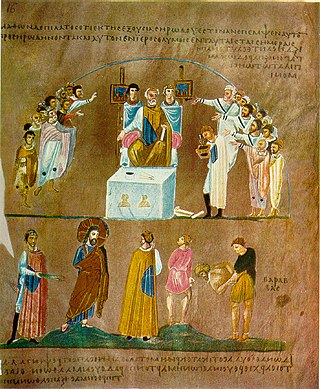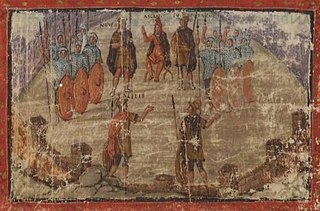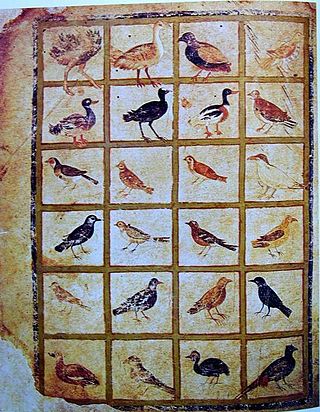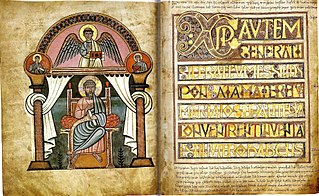
Publius Terentius Afer, better known in English as Terence, was a Roman African playwright during the Roman Republic. His comedies were performed for the first time around 166–160 BC. Terentius Lucanus, a Roman senator, brought Terence to Rome as a slave, educated him and later on, impressed by his abilities, freed him. It is thought that Terence abruptly died, around the age of 25, likely in Greece or on his way back to Rome, due to shipwreck or disease. He was supposedly on his way to explore and find inspiration for his comedies. His plays were heavily used to learn to speak and write in Latin during the Middle Ages and Renaissance Period, and in some instances were imitated by William Shakespeare.

The Codex Vaticanus, designated by siglum B or 03, δ 1, is a fourth-century Christian manuscript of a Greek Bible, containing the majority of the Greek Old Testament and the majority of the Greek New Testament. It is one of the four great uncial codices. Along with Codex Alexandrinus and Codex Sinaiticus, it is one of the earliest and most complete manuscripts of the Bible. The codex has been dated palaeographically to the 4th century.

The Rossano Gospels, designated by 042 or Σ, ε 18 (Soden), held at the cathedral of Rossano in Italy, is a 6th-century illuminated manuscript Gospel Book written following the reconquest of the Italian peninsula by the Byzantine Empire. Also known as Codex purpureus Rossanensis due to the reddish-purple appearance of its pages, the codex is one of the oldest surviving illuminated manuscripts of the New Testament. The manuscript is famous for its prefatory cycle of miniatures of subjects from the Life of Christ, arranged in two tiers on the page, sometimes with small Old Testament prophet portraits below, prefiguring and pointing up to events described in the New Testament scene above.

The Vatican Apostolic Library, more commonly known as the Vatican Library or informally as the Vat, is the library of the Holy See, located in Vatican City, and is the city-state's national library. It was formally established in 1475, although it is much older—it is one of the oldest libraries in the world and contains one of the most significant collections of historical texts. It has 75,000 codices from throughout history, as well as 1.1 million printed books, which include some 8,500 incunabula.

The Vergilius Vaticanus, also known as Vatican Virgil, is a Late Antique illuminated manuscript containing fragments of Virgil's Aeneid and Georgics. It was made in Rome in around 400 CE, and is one of the oldest surviving sources for the text of the Aeneid. It is the oldest and one of only three ancient illustrated manuscripts of classical literature.

The Vergilius Romanus, also known as the Roman Vergil, is a 5th-century illustrated manuscript of the works of Virgil. It contains the Aeneid, the Georgics, and some of the Eclogues. It is one of the oldest and most important Vergilian manuscripts. It is 332 by 323 mm with 309 vellum folios. It was written in rustic capitals with 18 lines per page.

The Cotton Genesis is a 4th- or 5th-century Greek Illuminated manuscript copy of the Book of Genesis. It was a luxury manuscript with many miniatures. It is one of the oldest illustrated biblical codices to survive to the modern period. Most of the manuscript was destroyed in the Cotton library fire in 1731, leaving only eighteen charred, shrunken scraps of vellum. From the remnants, the manuscript appears to have been more than 440 pages with approximately 340-360 illustrations that were framed and inserted into the text column. Many miniatures were also copied in the 17th century and are now in the Bibliothèque nationale de France in Paris.

The Vergilius Augusteus is a manuscript from late antiquity, containing the works of the Roman author Virgil, written probably around the 4th century. There are two other collections of Virgil manuscripts, the Vergilius Vaticanus and the Vergilius Romanus. They are early examples of illuminated manuscripts; the Augusteus is not illuminated but has decorated initial letters at the top of each page. These letters do not mark divisions of the text, but rather are used at the beginning of whatever line happened to fall at the top of the page. These decorated initials are the earliest surviving such initials.

The Vienna Dioscurides or Vienna Dioscorides is an early 6th-century Byzantine Greek illuminated manuscript of an even earlier 1st century AD work, De materia medica by Pedanius Dioscorides in uncial script. It is an important and rare example of a late antique scientific text. After residing in Constantinople for just over a thousand years, the text passed to the Holy Roman Emperor in Vienna in the 1500s, a century after the city fell to the Ottomans.

The Stockholm Codex Aureus is a Gospel book written in the mid-eighth century in Southumbria, probably in Canterbury, whose decoration combines Insular and Italian elements. Southumbria produced a number of important illuminated manuscripts during the eighth and early ninth centuries, including the Vespasian Psalter, the Stockholm Codex Aureus, three Mercian prayer books, the Tiberius Bede and the British Library's Royal Bible.

Carolingian art comes from the Frankish Empire in the period of roughly 120 years from about 780 to 900—during the reign of Charlemagne and his immediate heirs—popularly known as the Carolingian Renaissance. The art was produced by and for the court circle and a group of important monasteries under Imperial patronage; survivals from outside this charmed circle show a considerable drop in quality of workmanship and sophistication of design. The art was produced in several centres in what are now France, Germany, Austria, northern Italy and the Low Countries, and received considerable influence, via continental mission centres, from the Insular art of the British Isles, as well as a number of Byzantine artists who appear to have been resident in Carolingian centres.
Liber diurnus Romanorum pontificum is the name given to a miscellaneous collection of ecclesiastical formulae used in the Papal chancery until about the 11th century. It fell into disuse through the changed circumstances of the times and was soon forgotten and lost.

The Naples Dioscurides, in the Biblioteca Nazionale, Naples, is an early 7th-century secular illuminated manuscript Greek herbal. The book has 172 folios and a page size of 29.7 x 14 cm and the text is a redaction of De Materia Medica by the 1st century Greek military physician Dioscorides, with descriptions of plants and their medicinal uses. Unlike De Materia Medica, the text is arranged alphabetically by plant.

The Chronograph of 354, also known as the Calendar of 354, is a compilation of chronological and calendrical texts produced in 354 AD for a wealthy Roman Christian named Valentinus by the calligrapher and illustrator Furius Dionysius Filocalus. The original illustrated manuscript is lost, but several copies have survived. It is the earliest dated codex to have full page illustrations. The term Calendar of Filocalus is sometimes used to describe the whole collection, and sometimes just the sixth part, which is the Calendar itself. Other versions of the names are occasionally used. The text and illustrations are available online.

Papyrus 72 is the designation used by textual critics of the New Testament to describe portions of the so-called Bodmer Miscellaneous codex, namely the letters of Jude, 1 Peter, and 2 Peter. These books seem to have been copied by the same scribe, and the handwriting has been paleographically assigned to the 3rd or 4th century.
The Codex Vaticanus is one of the oldest and most valuable extant manuscripts of the Greek Bible. In addition to that most common reference, however, the term may refer to any other of the manuscripts preserved in the Vatican Library, a partial list of which follows:

Codex Marchalianus designated by siglum Q is a 6th-century Greek manuscript copy of the Greek version of the Hebrew Bible known as the Septuagint. The text was written on vellum in uncial letters. Palaeographically it has been assigned to the 6th century. Marginal annotations were later added to the copy of the Scripture text, the early ones being of importance for a study of the history of the Septuagint.
Minuscule 850, Κι20, is a 12th-century Greek minuscule manuscript of the New Testament on parchment. The manuscript has no complex content.

The Sacra Parallela is a Byzantine florilegium of quotes from the Bible and patristic texts used in the instruction of ethics, morals and asceticism.
Codex Bembinus is the oldest surviving manuscript containing the comedies of the Roman playwright Terence. It dates back to the 4th or 5th century, and is stored in the Vatican Archives. It is written in Rustic capitals. The manuscript was once owned by Bernardo Bembo, and subsequently Fulvio Orsini, before entering the archives in 1600.

















